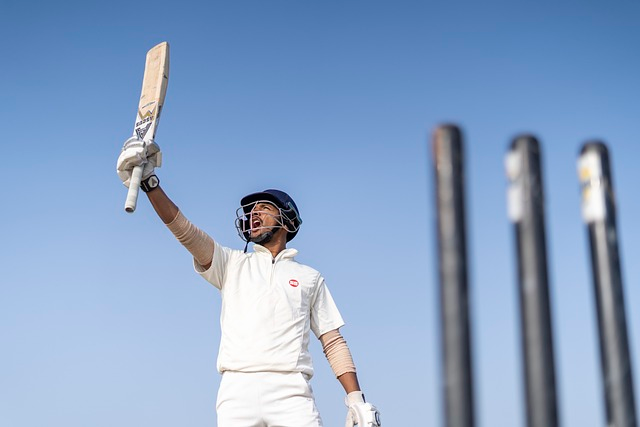Last updated on October 25th, 2023 at 11:28 am
How Many Overs In Test Cricket

What is test matches?
Test matches are a form of cricket that represents the pinnacle of the sport where teams play test cricket’s traditional and longest format. They are a fundamental component of international cricket and are played between two national teams, each representing national representative teams of their respective countries. Test matches are considered the most prestigious and challenging form of the game due to their unique characteristics and the strategic depth they require from players.
Key features of Test matches:
1. Duration: Test matches are played over a maximum of five days, with each team having two innings to bat and the bowling side two innings to bowl. If the match does not reach a conclusion in five days, it can end in a draw, but this is relatively rare.
2. Format: A Test match typically consists of two hours four innings – two hours per innings for each team. In each innings to play test cricket, a team bats until either 10 of its players are dismissed (bowled out, caught, run out, etc.) or they declare their innings closed. The opposing team then gets the opportunity to bowl them out and subsequently bat.
3. Red Ball: Test matches are traditionally played with a red cricket ball, which tends to swing more and deteriorate over time compared to the white ball used in limited-overs formats. This adds an extra layer of challenge for both batsmen and bowlers.
4. Strategy and Tactics: Due to the longer duration of Test matches, players and teams need to exhibit a higher level of strategic planning and tactical acumen. Bowlers need to manage their workload effectively, while batsmen need to show patience and concentration to build substantial innings.
5. Pitch and Conditions: The condition of the pitch and the weather play crucial roles in determining the course of a Test match. Pitches may change in behavior over the course of five days, becoming more conducive to spin or favoring seam and swing bowling.
6. Batting Techniques: Batsmen in Test matches require solid defensive techniques to survive against high-quality bowling attacks. They must also possess a wide range of shots to score runs on various types of pitches.
7. Tradition and History: Test cricket has a rich history dating back to the 19th century. The Ashes series between England and Australia, for instance, is one of the most celebrated and enduring rivalries in sports history.
8. Records and Statistics: Test matches have witnessed the establishment of numerous records and milestones. Players aspire to score centuries (100 runs), take five-wicket hauls (5 wickets in an innings), and achieve other significant achievements in the international cricket matches.
9. Series and Rankings: Test matches are often played as part of a series, where two teams compete against each other over multiple matches. The result and test status of third team in the series is determined by the cumulative outcomes of one team in these matches. The International Cricket Council (ICC) maintains rankings for Test-playing nations based on their performance over time.
Test matches hold a special place in international cricket-ing culture and remain a test of skill, patience, and endurance for both players and fans. They offer a unique opportunity to witness the ebb and flow of the game over an extended period playing time, showcasing the true essence of cricket as a sport.
Embark on the Fun Ride: Join the Excitement at Fun88! Don’t miss out on the thrill – register now at Fun88
Evolution and Origins of Overs in Test Cricket: A Historical Overview
The concept of overs in Test cricket, the longest form of the game, evolved from an unstructured approach in cricket’s early days. Matches had no set number of or how many overs in test cricket; bowlers kept going until tiredness or dismissals. As cricket grew, standardization became necessary. In the 1800s, matches began with 4-ball overs, later moving to 5 and eventually settling on 6-ball overs. This format was established in the late 19th century when Test cricket took shape. In modern Test cricket, each team gets 90 overs a day, totaling 540 deliveries. A Test match spans up to five days, allowing a maximum of 450 overs (2700 deliveries) per team. The evolution of overs in Test cricket reflects the balance between competition and practicality.
How many overs in Test cricket – Session, Innings and Day
In Test cricket, the allocation of overs is structured across various units of play: sessions, innings, and days. These divisions help maintain the balance between the batting and bowling sides while ensuring a reasonable pace of play.
1. Session: A Test match day is divided into three sessions: the morning session, the afternoon session, and the evening session (if applicable). Each session is typically 2 hours and 30 minutes long. During these sessions, a predetermined number of overs is bowled. This number two overs can vary due to factors like playing conditions, the state of the match, and weather disruptions. Generally, a session consists of approximately 30-35 overs, though this amount two overs can fluctuate based on the pace of play and interruptions.
2. Innings: In a Test match, each team bats and bowls twice, constituting two innings for each team. An an innings ends or an innings concludes, when either 10 batsmen are dismissed, the team captain declares the innings closed, or the target set by the opposition is achieved (in the case of the fourth innings). The number of overs bowled in an innings is determined by the batting and bowling team’s progress and the available time in the match. If the batting or bowling team is dismissed before the allocated overs, the remaining overs are added to the opposing or bowling team”s innings.
3. Day: A Test match typically spans five days, allowing for a total of 15 sessions. Over the course of these five days, both teams have the opportunity to bat and bowl twice. In each session times a day’s play, the teams aim to bowl the allocated number of overs within the three sessions. However, factors such exceptional circumstances such as rain, bad light, or interruptions can impact the number of overs bowled in each session times a day’s play.
Given the time constraints and the desire to maintain a balance between the batting and bowling aspects of the game, these divisions help regulate the flow of a play in official Test match of cricket match. The goal is to ensure that both teams have a fair chance to compete, while also accommodating external factors that might affect the pace of play. The structure of sessions, innings, and days in official Test match of cricket is designed to capture the strategic depth and endurance that make this format so unique and cherished by cricket enthusiasts.
How many overs in Test cricket are bowled in an innings?
In Test cricket, there is no fixed number of overs that are bowled in an innings. The number of overs bowled in an innings can vary based on several factors, including the batting team’s progress, the available time in the match, and the decisions made by the teams’ captains.
Traditionally, Test matches have seen innings ranging from around 50 overs to well over 150 overs, depending on the pace of play, wicket conditions, and the overall match situation. There have been instances where teams have been bowled out quickly, resulting in shorter innings, while in other cases, teams have batted for extended periods playing time, resulting in longer innings.
In the context of a five-day Test match, teams aim to strike a balance between scoring runs and conserving wickets, while also considering the time needed to bowl out the opposing team. The number of overs bowled in an innings is not predetermined and can vary significantly from one match to another.
Ready to elevate your cricket knowledge? Click here to explore more!
How many overs in Test cricket are bowled over the course of the match?
In Test cricket, the total number of overs bowled over the course of a match can vary depending on several factors, including the pace of play, interruptions due to adverse weather, or bad light, and the state of the match. However, there is a general guideline that helps determine the maximum number of overs possible in a Test match.
In a traditional five-day Test match, with three sessions per day, each team is typically allowed to bowl a maximum of 90 overs in a fifth day over. Therefore, if the last session of the fifth day of match progresses without any interruptions, each team has the potential to bowl a total of 450 overs in the entire Test match (5 days × 90 overs + final session per day = 450 overs).
However, it’s important to note that bad weather, disruptions, bad light, and other unforeseen circumstances can lead to a reduction in the number of overs bowled. If the final session of play is affected by rain or other factors, overs may be lost, and the match might end up with fewer overs bowled overall.
Additionally, if an innings is completed before the allocated overs, the remaining overs are added to the bowling team’s total in the subsequent innings. This further impacts the overall number of overs bowled in the match.
In summary, while the maximum possible number of overs that can be bowled in a traditional five-day Test match is 450 overs per two team bowling side, the actual number of overs can vary based on the factors mentioned above.
How many overs in Test cricket are bowled in a session?
In Test cricket, a session typically consists of 30 to 35 overs. The exact number of overs bowled in a session can vary based on the pace of play, interruptions due to bad weather or other factors, and the decisions made by the teams’ captains.
Sessions are structured to last around 2 hours and 30 minutes each, with the morning session, afternoon session, and sometimes an evening session (if applicable) collectively making up two hours of a day’s play. This division helps maintain a balance between the batting side and bowling side of sides while also ensuring a reasonable pace of play.
It’s important to note that while the target range for overs in a session is around 30 to 35, this can be influenced by factors such as the number of wickets that have fallen, the flow of the game, and the teams’ strategic considerations.
Rules
In Test cricket, there are certain rules and regulations regarding the number of overs that are bowled, both at the team and individual bowler levels first class matches. Here are the key rules related to how many overs are in a Test match:
1. Maximum Number of Overs in an Innings: In a Test innings, the batting team can face a maximum of 90 overs in a day’s play, divided into three sessions. This means that each team can bowl up to 90 overs in a day’s play.
2. Minimum Number of Overs in a Match: There is no specific minimum number of overs required to be bowled in a cricket Test match anywhere. However, for a Test cricket match to be valid and considered complete, a certain number of overs must be bowled in the entire match. The minimum number of overs varies depending on the length of the match (usually a certain percentage of the total overs allocated for the match).
3. Change of Ends: At the end of each over, the bowler with new ball switches ends with new ball with the other bowler operating the new ball from the opposite end. This new ball alternation allows for a fair distribution of conditions for both batsmen.
4. Number of Bowlers: Any number of bowlers can be used by a team in a Test match, subject to certain rules about their bowling actions. However, a single bowler cannot bowl more than 90 overs in a Test match.
5. Limited Overs per Bowler: A bowler cannot bowl more than one-fifth (20%) of the total overs available to the fielding team in a single Test innings. For example, if a bowling team side is allotted 90 overs, a single bowler can bowl a maximum of 18 overs in that innings.
6. Declaration: The batting team’s captain can declare their own bowling side’ team’s innings closed at any point during their team batting’ innings. This is often done to set a target for other team of the opposition to chase within a specific number of overs.
7. Completion of Overs: If an innings is completed before the allocated number of overs, the remaining overs are added to the bowling team’s quota in the subsequent innings.
8. Overs Lost to Interruptions: If a day’s play is interrupted by rain, bad light, or other factors, the overs of lost playing time are usually compensated by extending the scheduled play time on subsequent days.
These rules ensure that Test matches are played within a structured framework, balancing the interests of both batting and bowling teams. The flexibility in the rules also accounts for various match situations and conditions that might affect the pace of play.
Historical Records:
Here are some notable historical records related to the number of overs bowled in Test matches:
Most Overs Bowled in a Test Match: The record for the most overs bowled in a single Test match is 200.5 overs, achieved in the match between South Africa and England at Durban on March 3-7, 1939. This lengthy match had a total of 1,205 legal deliveries bowled, which is still a record for the highest number of deliveries in a Test match.
Fewest Overs Bowled in a Test Match: The record for the fewest overs bowled in a completed Test match is 193 overs, achieved in the match between England and South Africa at The Oval on August 25-27, 1947. This match lasted only three days, and England bowled 77.1 overs in their innings, while South Africa bowled 115.5 overs in their innings.
Longest Innings: The record for the longest innings in terms of overs bowled is held by South Africa, who bowled a remarkable 200.3 overs during India’s second innings in a Test match at the Eden Gardens in Kolkata on February 28 – March 4, 2010. This marathon bowling effort took place over five days.
Fewest Overs in an Innings: The record for the fewest overs bowled in an innings is 10.3 overs, achieved in the Test match between South Africa and Australia at Melbourne on March 11-15, 1932. This exceptionally short innings occurred during the notorious “Bodyline Series.”
These records highlight the variety of situations and conditions that Test cricket has seen over the last hour years. They also showcase the unique challenges and achievements of bowlers and teams in different contexts.

How Many Overs In Test Cricket
Frequently Asked Questions (FAQ)
Is there a limit of overs in Test cricket like limited overs cricket?
No, there is no fixed limit of overs in Test cricket like there is in limited overs cricket. In Test cricket, each team is allowed to bowl as many how many overs, how many overs in test cricket, as needed to dismiss the opposition’s batting lineup. The number of overs bowled in a Test match can vary based on factors like pace of play, interruptions, and the decisions of the teams’ captains.
What types of bets are available for SRL matches?
Various types of bets are typically available for simulated cricket, including but not limited to, betting on the match winner, top run-scorer, top wicket-taker, total runs scored, and specific player performance-related bets like centuries or half-centuries.
What is the longest cricket game?
The longest cricket game in terms of time was the Test match between South Africa and England played in Durban from March 3 to March 14, 1939. This match lasted for a total of 12 days with lost time, due to a combination of rain interruptions and the time available for play. It still holds the record for the longest Test cricket match in terms of time lost and of the playing time in days.
How long is a day in Test matches?
A day in Test matches typically consists of three sessions and spans approximately 6 hours of play, divided into a morning session, an afternoon session, and, if applicable, an evening session.
What is the shortest Test match ever?
The shortest Test match ever, in terms of completed innings, lasted just two days. It was the Test match between England and Australia, played at Old Trafford in Manchester from four day test matches August 27 to one day internationals August 28, 1888. the four day test matches England batted first and scored 294, and then bowled out Australia for 65 and 122 in their two innings, respectively. England won the match by an innings and 23 runs on the second and final day only.
What is the maximum number of overs a team can bowl in a day of a Test match?
The maximum number of overs a team can bowl in a day of a Test match is 90 overs. This allocation is divided into three sessions: the morning or first session only, the final session of the afternoon session, and the final session of the evening session (if applicable). Each session is typically around 2 hours and 30 minutes long
How long is tea in a Test match?
Tea break in a Test match usually lasts for about the last hour to one hour and 20 minutes.















